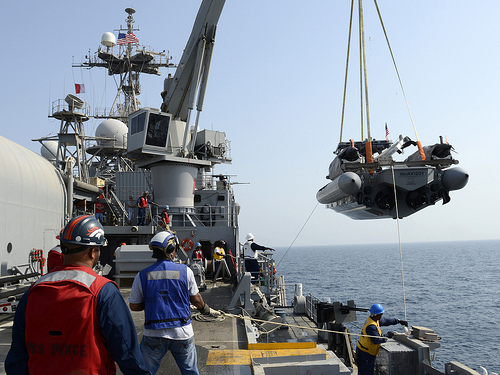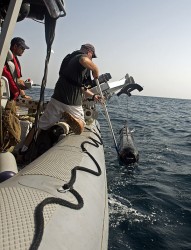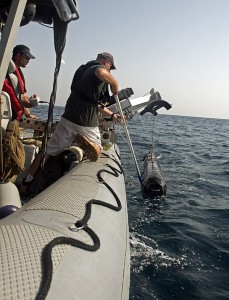As discussed in an earlier post, dynamics between unmanned naval systems and the platforms that carry them are changing rapidly to accommodate new technologies and tactics. Arguably, various types of drone motherships have the potential to transform mine countermeasures more than any other warfare area, and the evolution in mine-countermeasures tactics towards the mothership-unmanned underwater vehicle (UUV) partnership is already underway. One of the first major demonstrations of this concept occurred last summer during the U.S. 5th Fleet’s International Mine Countermeasures Exercise (IMCMEX), when a number of UUVs were tested from large amphibious motherships including USS Ponce (AFSB(I)-15).
Essentially, the Navy is moving from dedicated MCM ships, such as the Avenger-class minesweeper, to a trio of platforms operating together: a Generation I mothership (ex: an AFSB) carrying Generation II platforms (ex: manned RHIBs) and the UUVs themselves. The Gen I mothership provides the endurance and sustainment to the package. The RHIBs (specially modified to carry UUVs, as pictured below) take the mine-hunting or neutralization payloads off-board to minimize danger to the larger mothership. And the payloads – in this case, high-resolution imaging sonars – are delivered to the target area via a small UUV. Another option for getting the sensor/sweeping delivery systems to their operating area is using drones carrying drones, such as the French Espadon or Fleet-class Common Unmanned Surface Vessels (CUSV), launched from Gen III motherships like the Littoral Combat Ship’s (LCS).

A further example of an innovative drone carrier was revealed during the January 2013 Surface Navy Association’s annual meeting, when Major General Timothy C. Hanifen, USMC, Director, of OPNAV’s Expeditionary Warfare Division (N95) discussed how the U.S. Navy will demonstrate the forthcoming MK VI Coastal Patrol Boat to carry and launch UUVs for mine hunting and neutralization.
There are likely a couple of reasons for this movement towards alternative motherships such as USS Ponce and smaller platforms like the MK VI to carrying MCM drones. Clearing an area of mines is a complicated, methodical operation. Simply described, mine clearance involves getting equipment (sonar, sweeping gear, and/or neutralization charges) on target to locate, classify, and neutralize mines as rapidly as possible in a port, shipping lane, or other expanse of water. Generally speaking, more sensors moving more quickly over a wider area will complete the mission in less time, which is why airborne mine-sweeping and -hunting operations have proven so important. Deploying smaller manned and unmanned craft from a larger ship, each carrying more than one mine-hunting or mine-neutralization vehicle will get more mine-hunting equipment in the water. A single minesweeper can utilize one sonar and moves slowly through the water from mine to mine. The mothership/drone combination multiplies the number of sonars in the water several times. This unconventional platform experimentation is also likely a response to the technical problems and delays in deploying a viable mine warfare mission package on the Littoral Combat Ship, especially with the RMMV.
The Chief of Naval Operations’ push for “payload over platforms” will lead to additional experimentation with other mothership/drone pairings. Expect to see new combinations of unmanned vehicle carriers expanded into other warfare areas, including anti-surface (ASUW), anti-submarine (ASW), and intelligence, surveillance, and reconnaissance (ISR).
This article was re-posted by permission from, and appeared in its original form at NavalDrones.com.


